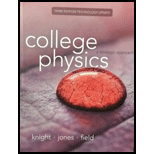
Concept explainers
The state of the charge on balls
Answer to Problem 1CQ
The ball
Explanation of Solution
When a plastic rod is rubbed with wool, the plastic rod acquires negative charge on it because from charge model, the rubbing charges the objects by transferring charge from one to the other.
The ball
Case 1: Balls
The charge model states that two objects with same charge exert repulsive force on each other and two objects with different charge exert attractive force on each other.
The neutral objects have an equal mixture of positive and negative charge and they can be attracted by positively or negatively charged body due to charge polarization.
The balls
Case 2 : Balls
Both balls,
Case 3 : Ball
Ball
Conclusion:
Thus, the ball
Want to see more full solutions like this?
Chapter 20 Solutions
College Physics
- Pls help ASAParrow_forward12. A motorboat traveling 6 m/s, West encounters a water current travelling 3.5 m/s, South. a) Draw a vector diagram showing the resultant velocity, then determine the resultant velocity of the motorboat. b) If the width of the river is 112 m wide, then how much time does it take for the boat to travel shore to shore? c) What distance downstream does the boat reach the opposite shore?arrow_forwardLake Erie contains roughly 4.00⋅10114.00⋅1011 m3 of water. Assume the density of this water is 1000. kg/m3 and the specific heat of water is 4186 J/kg˚C. It takes 2.31x10^19 J of energy to raise the temperature of that volume of water from 12.0 °C to 25.8 ˚C. An electric power plant can produce about 1110 MW. How many years would it take to supply this amount of energy by using the 1110 MW from an electric power plant?arrow_forward
- Pls help ASAParrow_forwardPls help ASAParrow_forwardm m $2° 15. A truck is stopped at a red light. Once the light turns green, the truck accelerates forward at 1.75- that same instant, a car moving with a constant speed of 50 — passes the truck. a) How many seconds will it take for the truck to catch up to the car? S b) How many metres will the truck travel before it catches up to the car? Atarrow_forward
- Pls help ASAParrow_forwardI need help adding more information to my study guide. This is subject is physics My topic : Emission Spectrum Target Material I need information on this topic but make it as study guide form and make 5 questions and include the answers.arrow_forwardAn electron and a proton are each moving at 755 km/s in perpendicular paths as shown in (Figure 1). Find the magnitude of the total magnetic force that the electron exerts on the proton. Find the magnitude of the total electrical force that the electron exerts on the proton.arrow_forward
 College PhysicsPhysicsISBN:9781305952300Author:Raymond A. Serway, Chris VuillePublisher:Cengage Learning
College PhysicsPhysicsISBN:9781305952300Author:Raymond A. Serway, Chris VuillePublisher:Cengage Learning University Physics (14th Edition)PhysicsISBN:9780133969290Author:Hugh D. Young, Roger A. FreedmanPublisher:PEARSON
University Physics (14th Edition)PhysicsISBN:9780133969290Author:Hugh D. Young, Roger A. FreedmanPublisher:PEARSON Introduction To Quantum MechanicsPhysicsISBN:9781107189638Author:Griffiths, David J., Schroeter, Darrell F.Publisher:Cambridge University Press
Introduction To Quantum MechanicsPhysicsISBN:9781107189638Author:Griffiths, David J., Schroeter, Darrell F.Publisher:Cambridge University Press Physics for Scientists and EngineersPhysicsISBN:9781337553278Author:Raymond A. Serway, John W. JewettPublisher:Cengage Learning
Physics for Scientists and EngineersPhysicsISBN:9781337553278Author:Raymond A. Serway, John W. JewettPublisher:Cengage Learning Lecture- Tutorials for Introductory AstronomyPhysicsISBN:9780321820464Author:Edward E. Prather, Tim P. Slater, Jeff P. Adams, Gina BrissendenPublisher:Addison-Wesley
Lecture- Tutorials for Introductory AstronomyPhysicsISBN:9780321820464Author:Edward E. Prather, Tim P. Slater, Jeff P. Adams, Gina BrissendenPublisher:Addison-Wesley College Physics: A Strategic Approach (4th Editio...PhysicsISBN:9780134609034Author:Randall D. Knight (Professor Emeritus), Brian Jones, Stuart FieldPublisher:PEARSON
College Physics: A Strategic Approach (4th Editio...PhysicsISBN:9780134609034Author:Randall D. Knight (Professor Emeritus), Brian Jones, Stuart FieldPublisher:PEARSON





